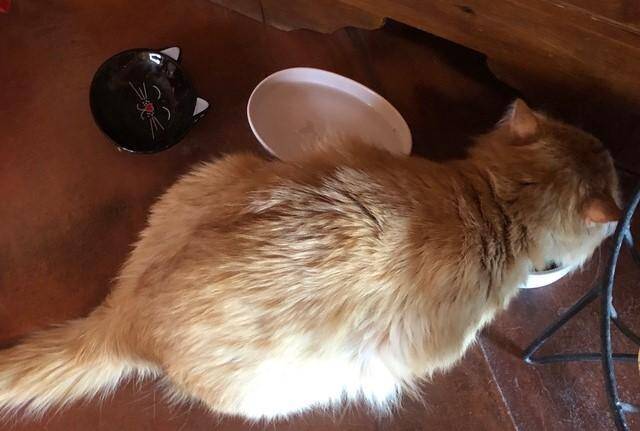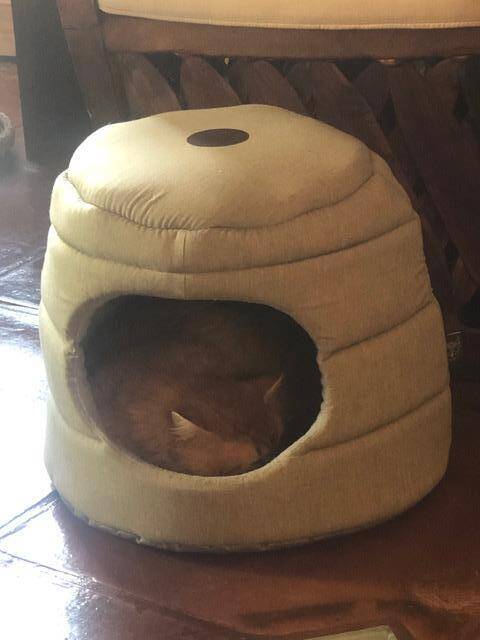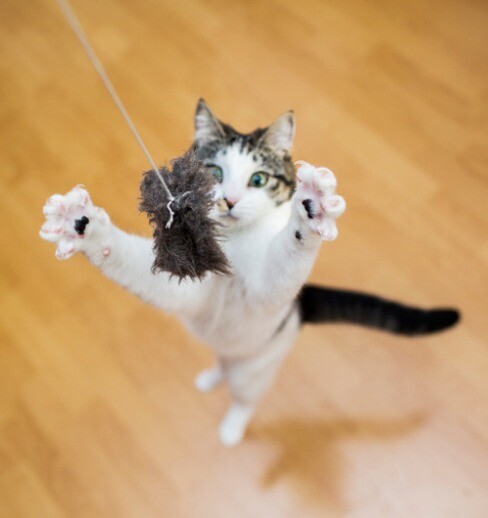In several interviews in August and September with Luis Camacho, the host of Channel 8’s morning program “Despierta Guanajuato,” Tony López and Julia Salido resumed an extended conversation about the things that cats need to live long and healthy lives.
Water. As with dogs, cats need daily access to fresh, clean water. Purified water is optimal, but you can use tap water too.

Food. Cats are carnivores. Their diet should consist of high-quality food that is formulated for cats. It should include fresh, raw, canned, or home-cooked food. You should avoid feeding your cat only dried food, which consists mainly of grains and carbohydrates, and can cause dehydration leading to bladder and kidney problems.
Some foods that we humans eat can be harmful and even fatal to cats. (See the list in the box.)
Feed your cat twice a day and be consistent with the feeding schedule. To avoid overfeeding your cat, don’t leave out a big bowl of dried food. Wash your cat’s water bowl and food bowl frequently.
A place for your cat to do his business. If yours is an indoor cat, he needs an accessible litter box filled with commercially made sand where he can relieve itself. Use a slotted spoon to remove the feces and clumps of urine from the box each day. Once a week the box needs to be emptied, thoroughly cleaned, and refilled with fresh sand.
Places to sleep and observe her surroundings. Cats sleep much of the time, and they like to sleep and perch in high places, where they can feel secure. Offer your cat several places to sleep, such as a cozy cat bed, a basket or box placed above the floor, a pillow, or a “cat tree” with a soft platform on top. Your cat may want to snuggle with you when you are sleeping or curl up on your lap.


Foods and beverages harmful to cats
- Alcoholic beverages
- Dairy products, including milk and cream*
- Apples, apricots, cherries, peaches, plums
- Bones, especially cooked bones
- Bread dough
- Chocolate
- Coffee grounds or beans
- Fatty foods, which can cause pancreatitis
- Grapes and raisins
- Moldy or spoiled food
- Nutmeg
- Onions and garlic
- Peanut butter
- Raw eggs
- Raw fish
- Tuna (large amounts)
- Raw potatoes
*If you have an unweaned kitten and a lactating cat is not available to feed her, ask your veterinarian what kind of milk you should use.
Important warning for cat owners
Plastic, paper, ties and string used to wrap meat, and sewing thread when swallowed can be life-threatening.
Source: PetPartners, Inc.
An interesting and safe environment. Your cat will likely live a long, happy life if he lives indoors and has plenty of stimuli to keep him active. An indoor cat can live 15 to 20 years if he receives good care. In contrast, the average life expectancy of outdoor cats is only a couple of years. That is because when outdoors—especially if cats can roam beyond an enclosed yard or garden—they are exposed to many hazards: attacks by other cats and by dogs, infectious diseases, and vehicular traffic. Outdoors they also pose a threat to birds and other wildlife.
Being natural hunters, cats enjoy playing with toys that allow them to chase and catch moving objects. A simple toy that can entertain a cat many times is a piece of wadded paper or aluminum foil that is tossed or rolled along the floor. Many cats enjoy chasing the light from a laser pointer. You should try to spend 15-30 minutes playing with you cat a couple of times a day.
Annual checkup, vaccinations, and sterilization. Your cat should see a veterinarian once a year and be vaccinated against common infectious diseases. Even if your cat lives indoors and is not likely to encounter other cats, it’s advisable to sterilize him or her to prevent behavioral problems such as caterwauling by a female when she’s in estrus or frequent, obnoxious-smelling marking of his territory (including your furniture) if your cat is a male.
Grooming. Cats are naturally fastidious, and they groom themselves. For trimming their nails, indoor kitties need materials to scratch. It’s easy to make a scratching post from a split log wrapped with sisal rope and securely propped against a wall. It should be at least 30 inches high so that your cat can stretch while scratching. Some cats prefer to scratch horizontal surfaces, such as carpeting. Give your cat a selection of surfaces to scratch; without appropriate scratching surfaces, it will destroy things you value.
If your cat’s nails become too long despite the availability of a good scratching surface, you should trim its nails or have them trimmed by a professional. Doing this will help protect your furniture. We strongly advise against having your cat declawed because that is inhumane. A cat needs to be able to scratch himself, and a declawed cat cannot defend himself if he is attacked.
You should brush your cat once a week or so and check for fleas and flea dirt (black specks that indicate that fleas are present). If you find them, apply a veterinary-approved flea powder, spray, or long-lasting drops to your cat, taking care to avoid its eyes, nose, mouth, and genitals.
Your vet may recommend that you brush your cat’s teeth several times a week, using a soft toothbrush and a veterinary-approved toothpaste formulated for cats. If you want to be super conscientious you may be able to train your cat to accept this procedure. But be careful not to be bitten by your cat, as a cat bite can cause a serious infection.
Protection against being lost. Finally, cats are naturally curious, and they have an uncanny ability to escape from their surroundings. If you want to avoid the anxiety, inconvenience, and expense of searching for a beloved pet—and possibly losing it forever—we recommend that your cat wear a collar with an ID tag, whether it normally goes outdoors or not.


